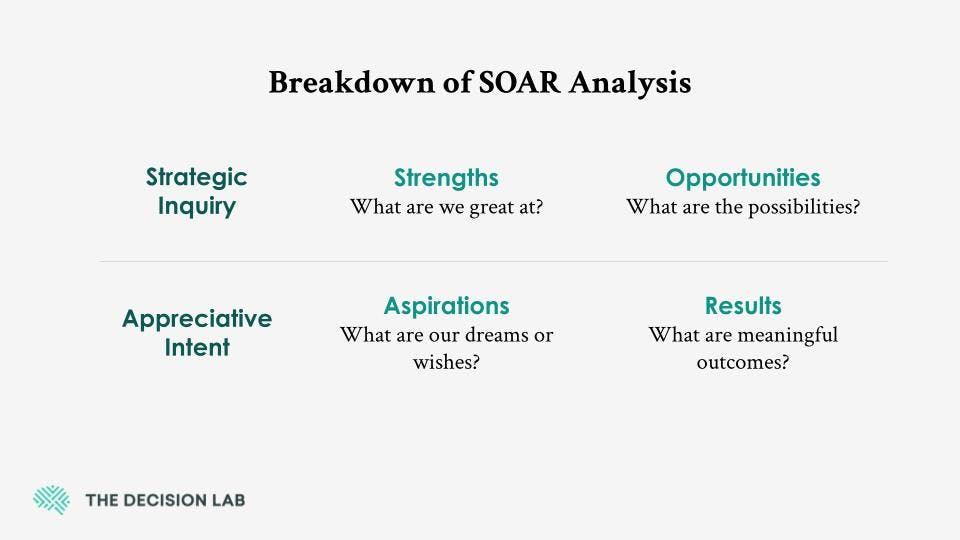SOAR Analysis
What is SOAR Analysis?
A SOAR analysis is a strategic planning framework rooted in appreciative inquiry (AI) that is composed of four features—Strengths (S), Opportunities (O), Aspirations (A), and Results (R)—that can be applied to individuals or businesses at a system-wide level.
The Basic Idea
In modern work culture, constant back-to-back meetings have become the new norm. More often than not, these meetings are oriented toward potential threats for a company like competing markets, leaving us thinking: what’s with all the negativity?
To inspire a more optimistic, energizing way of thinking, a SOAR analysis may be just the solution, regardless of what role someone may play in their organization.
A SOAR analysis is a framework used to guide constructive conversations by focusing on the four aspects of its acronym: Strengths (S), Opportunities (O), Aspirations (A), and Results (R). A company’s current capabilities may be investigated using SOAR from the perspective of all employees at all levels of the organization, which can then be applied to achieve long-term and sustainable growth. SOAR is especially useful for establishing a mutually agreed-upon pathway to success.1
The analysis begins with a strategic inquiry, where an organization’s most important Strengths and Opportunities are discovered and explored by its employees.1 This is followed by stating an appreciative intent—where employees share their Aspirations for their company while simultaneously recognizing and rewarding contributions to achieve Results.1
To fully understand SOAR, it is key to lay out each of the four questions that company managers should be asking all of their employees based on the acronym:
- Strengths: What is our company great at?
- Opportunities: What are the possibilities of our company?
- Aspirations: What dreams or wishes does our company have?
- Results: What are the significant outcomes of our company?
A SOAR analysis commonly visualizes the four letters of its acronym using a 2 x 2 matrix:

SOAR is distinct from the ubiquitous SWOT (Strengths, Weaknesses, Opportunities, and Threats) analysis that is commonly seen across business management. SWOT is known to be the “old standby” for strategic planning models.1 In contrast to SOAR, strategists who conduct a SWOT analysis assess the threats a company faces to make recommendations for ensuing alternative plans for the organization. Instead of applying strategic inquiry and appreciative intent to its four acronym features, SWOT considers internal assessments (Strengths and Weaknesses) and external assessments (Opportunities and Threats).1
In contrast to a gap-focused, analysis-oriented SWOT, SOAR is a more positive, action-oriented method, discovering the potential of each individual within a company and how the collective group can define the future potential for the organization and its stakeholders. In essence, a SOAR analysis focuses on strengths and future potential, whereas a SWOT analysis focuses on weaknesses and looming threats when it comes to managing business strategy.
SOAR is the foundational framework of an appreciative inquiry (AI) approach for organizational change, which allows a business to focus on what matters the most: the future of the company and the people who work there. AI provides SOAR with its ability to do strategic inquiry while purposefully recognizing a company’s Strengths, Opportunities, Aspirations, and Results through the lenses of all employees.1
There is no one formula for success—a framework must be flexible, dynamic, and able to integrate with other approaches.
– Jaqueline Stavros, Strategist and SOAR Co-Founder
About the Author
Isaac Koenig-Workman
Isaac Koenig-Workman has several years of experience in mental health support, group facilitation, and public communication across government, nonprofit, and academic settings. He holds a Bachelor of Arts in Psychology from the University of British Columbia and is currently pursuing an Advanced Professional Certificate in Behavioural Insights at UBC Sauder School of Business. Isaac has contributed to research at UBC’s Attentional Neuroscience Lab and Centre for Gambling Research, and supported the development of the PolarUs app for bipolar disorder through UBC’s Psychiatry department. In addition to writing for TDL, he works as an Early Resolution Advocate with the Community Legal Assistance Society’s Mental Health Law Program, where he supports people certified under B.C.'s Mental Health Act and helps reduce barriers to care—especially for youth and young adults navigating complex mental health systems.



















